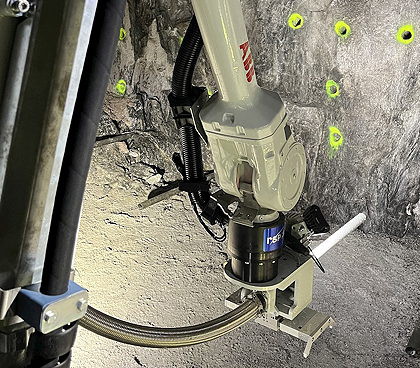in large mines, blasting can take place up to 15 times a day with the aim of expanding chambers to extract mineral and metal ores. ABB’s Robot Charger uses a vision system to detect drilled holes automatically, and then fills them with charges, avoiding the need for people to be near unsupported rock faces during blasting.
The tests have confirmed the effectiveness of integrating the robot charger with a carrier vehicle, communication with bulk emulsion and vision systems, and using a second robot arm to assemble and prime the detonator. The system can reach all areas of the rock face and boreholes at all levels, and allows operators to work remotely.
The test programme was undertaken at the world's most productive underground zinc mine, Boliden Garpenberg, 180km northwest of Stockholm.

ABB’s robotic system detects drilled holes in a rock face and installs explosive charges automatically
ABB is now embarking on a final stage of development with the aim of executing full blasting sequences in mines with control of the robot being handed over to the mine operator. It is also talking to other mine operators about joining the project, so that the technology can be tested in different mine environments and in areas away from Northern Europe where the rock composition and climate may be different.
“This is a significant technology development for ABB and the wider industry where safety is part of overall ESG commitments,” says Vedrana Spudic, head of technology in ABB’s mining business. “The robot locates the drilled holes on the rock face using a vision system, and these recent tests show all can be reached and charged with the cycle fully automated. This removes the need for human operators in a small, unsupported area right at the face.”
ABB Robotics: Twitter LinkedIn Facebook

